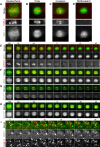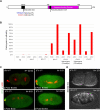This is a preprint.
Securin Regulates the Spatiotemporal Dynamics of Separase
- PMID: 38168402
- PMCID: PMC10760073
- DOI: 10.1101/2023.12.12.571338
Securin Regulates the Spatiotemporal Dynamics of Separase
Update in
-
Securin regulates the spatiotemporal dynamics of separase.J Cell Biol. 2025 Feb 3;224(2):e202312099. doi: 10.1083/jcb.202312099. Epub 2024 Nov 18. J Cell Biol. 2025. PMID: 39556062 Free PMC article.
Abstract
Separase is a key regulator of the metaphase to anaphase transition with multiple functions. Separase cleaves cohesin to allow chromosome segregation and localizes to vesicles to promote exocytosis in mid-anaphase. The anaphase promoting complex/cyclosome (APC/C) activates separase by ubiquitinating its inhibitory chaperone, securin, triggering its degradation. How this pathway controls the exocytic function of separase has not been investigated. During meiosis I, securin is degraded over several minutes, while separase rapidly relocalizes from kinetochore structures at the spindle and cortex to sites of action on chromosomes and vesicles at anaphase onset. The loss of cohesin coincides with the relocalization of separase to the chromosome midbivalent at anaphase onset. APC/C depletion prevents separase relocalization, while securin depletion causes precocious separase relocalization. Expression of non-degradable securin inhibits chromosome segregation, exocytosis, and separase localization to vesicles but not to the anaphase spindle. We conclude that APC/C mediated securin degradation controls separase localization. This spatiotemporal regulation will impact the effective local concentration of separase for more precise targeting of substrates in anaphase.
Figures







References
Publication types
Grants and funding
LinkOut - more resources
Full Text Sources
